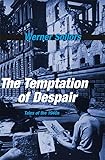The Temptation of Despair : Tales of the 1940s / Werner Sollors.
Material type: TextPublisher: Cambridge, MA : Harvard University Press, [2014]Copyright date: ©2014Description: 1 online resource (400 p.) : 44 halftonesContent type:
TextPublisher: Cambridge, MA : Harvard University Press, [2014]Copyright date: ©2014Description: 1 online resource (400 p.) : 44 halftonesContent type: - 9780674052437
- 9780674416314
- Denazification
- Geschichte Europas
- Reconstruction (1939-1951) -- Germany
- Social psychology -- Germany
- World War, 1939-1945 -- Art and the war
- World War, 1939-1945 -- Influence
- World War, 1939-1945 -- Literature and the war
- World War, 1939-1945 -- Motion pictures and the war
- HISTORY / Modern / 20th Century
- 940.55/4 23
- D829.G3 S56 2014eb
- online - DeGruyter
- Issued also in print.
| Item type | Current library | Call number | URL | Status | Notes | Barcode | |
|---|---|---|---|---|---|---|---|
 eBook
eBook
|
Biblioteca "Angelicum" Pont. Univ. S.Tommaso d'Aquino Nuvola online | online - DeGruyter (Browse shelf(Opens below)) | Online access | Not for loan (Accesso limitato) | Accesso per gli utenti autorizzati / Access for authorized users | (dgr)9780674416314 |
Frontmatter -- Contents -- Introduction -- ONE March 29, 1945: Between the No Longer and the Not Yet -- TWO May 7, 1945: Malevolent Rectangles of Spectral Horror -- THREE June 23, 1945: After Dachau -- FOUR October 4, 1945: Dilemmas of Denazifi cation -- FIVE January 8, 1946: Are You Occupied Territory? -- SIX April 24, 1946: The Race Problem in the House on Lilac Road -- SEVEN August 20, 1948 / May 6, 1977: Heil, Johnny -- Coda Comic Relief ? -- Afterword -- Notes -- Acknowledgments -- Index
restricted access online access with authorization star
http://purl.org/coar/access_right/c_16ec
In Germany, the years immediately following World War II call forward images of obliterated cities, hungry refugees, and ghostly monuments to Nazi crimes. The temptation of despair was hard to resist, and to contemporary observers the road toward democracy in the Western zones of occupation seemed rather uncertain. Drawing on a vast array of American, German, and other sources--diaries, photographs, newspaper articles, government reports, essays, works of fiction, and film--Werner Sollors makes visceral the experiences of defeat and liberation, homelessness and repatriation, concentration camps and denazification. These tales reveal writers, visual artists, and filmmakers as well as common people struggling to express the sheer magnitude of the human catastrophe they witnessed. Some relied on traditional images of suffering and death, on Biblical scenes of the Flood and the Apocalypse. Others shaped the mangled, nightmarish landscape through abstract or surreal forms of art. Still others turned to irony and black humor to cope with the incongruities around them. Questions about guilt and complicity in a totalitarian country were raised by awareness of the Holocaust, making "After Dachau" a new epoch in Western history. The Temptation of Despair is a book about coming to terms with the mid-1940s, the contradictory emotions of a defeated people--sorrow and anger, guilt and pride, despondency and resilience--as well as the ambiguities and paradoxes of Allied victory and occupation.
Issued also in print.
Mode of access: Internet via World Wide Web.
In English.
Description based on online resource; title from PDF title page (publisher's Web site, viewed 30. Aug 2021)


